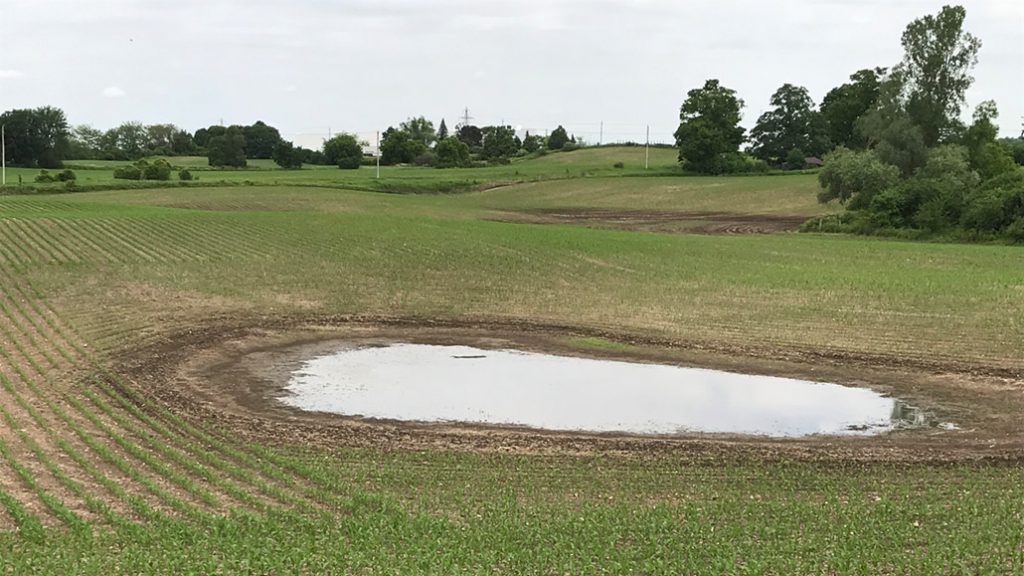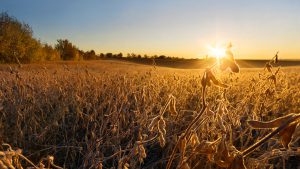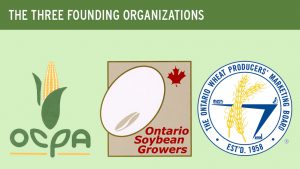Ten years of wild weather
WHAT PRODUCERS ARE DOING ABOUT IT

WEATHER-WISE, THE past decade has been fraught with extremes and variability. Ontario’s producers have been hit with bouts of excessive rain, untimely frosts, and oppressive heat waves. And while these incidents are normal, their frequency and timing is not. David Phillips, Senior Climatologist, Environment and Climate Change Canada, revisits the ups and downs of the past decades, and Ontario farmers share their secrets for future-proofing their farms.
No matter what your thoughts are on climate change and who’s to blame, one thing is for certain: weather in Ontario over the last 10 years has been less than “normal.” The confusion for some is that we’re not seeing any new weather.
“It’s not as if we’re seeing typhoons in Toronto and sandstorms in Sarnia,” says Phillips. “It’s the same old weather, but what’s different about it is its statistics have changed. It’s more frequent, it’s more intense, it’s longer lasting, it’s out of season, out of place… You’re seeing things you have seen before, but not quite the same detail, oomph or energy associated with it.”
Statistically, every season in Ontario is warmer today than it was 70 years ago. And the result, said Phillips, is more variability and greater extremes. Storms are stormier. Droughts are longer and drier. Floods are more extreme. Hailstones are bigger, and lightning strikes more frequently. What’s more, when storms do hit, they’re sticking around longer.
“It used to be that the greatest attribute of weather in Canada is that it hits and runs,” said Phillips. “It didn’t stand around and torment you like it does in other parts of the world. You get a storm and six hours later you’re cleaning up.”
Now, he said, they don’t move as quickly.
The second threat is increased variability, what Phillips calls “the Joker in the weather deck.”
LOOKING BACK
Beginning with the 2019 growing season, Phillips went on to point to incidents of concern. The year started off cold, he said. In fact, it was the second coldest spring in 22 years. Once it warmed up, heavy rainfall led to very wet conditions. The only thing that was growing was grass. Seeds were sitting and rotting in the fields. By the end of May, only five per cent of crops were in the ground.
“That combination of little sunshine, wet weather and cool weather really made for a totally difficult, challenging year,” said Phillips. “And then all of the sudden you turn the faucet off, and there was no rain in the summer.”
Because crops weren’t growing, producers began worrying that they would run into trouble come fall. “Farmers were saying if we have an early frost, it’s going to be game over,” said Phillips. “You hear that in the prairies all the time, but not in Ontario.”
Going back to the early part of the decade, it’s hard to forget the spring of 2012. There was almost no winter that year, but spring came in so quick it was confused. Temperatures skyrocketed to 29°C in Petawawa, Ont. In eastern Ontario, the last day of winter was warmer than anytime during the summer.
“There were parts of eastern Ontario that didn’t get warmer in the dog days of summer that year,” said Phillips. “How do you handle that? It’s almost as if you went from slush to sweat.”
“You saw people beaching in Ontario, garden centers were crowded, golf courses were packed,” he continued. “But farmers were nervous. They knew this was not good, and it wasn’t.”
Trees budded early, but were quickly followed by killer frost. Temperatures were suddenly brutally cold, dropping to -7°C three days in a row at the end of March in apple country. In April, temperatures shot up to 27°, and then the month finished with four days of killing frosts. Apple growers lost $100 million that year.
Producers experienced one of the latest harvests on record in 2014, and the following year was no better, recording the driest spring on record followed by a summer’s worth of rain in June. Farmers never recovered, said Phillips.
“Forty per cent of the fields of tomatoes and soybeans were sitting under water on the first day of summer, and most of the crops — almost 50 per cent — had to be either replanted or not planted at all,” he said.
Both 2016 and 2017 brought extremes and variability as well. In 2016, Ontario’s farmers experienced the hottest, driest summer on record in a century. Even if you irrigated, you could barely get a crop up. There were 35-degree days in every month from May to September. Oftentimes, temperatures stayed high right through the night. Potatoes, especially, suffer under these conditions.
“In a normal season, all agriculture in Ontario needs 20-25 mm of rain per month,” said Phillips. “In a hot summer, you need at least 50 per cent more. What you got was about half of the normal. You got about 10 mm per month, and in some weeks you got nothing.”
Some regions of the province were hit harder than others. In Vineland, for example, the region went 104 days without a significant rainfall. It didn’t matter what you were growing, said Phillips, it suffered.
As if 2016 wasn’t enough, 2017 brought the wettest growing season on record. From June 23 until the end of August there was barely a dry day in Ontario, and if it wasn’t raining, it looked like rain.
Summer did eventually come, said Phillips. In fact, temperatures got as high as 35°C, only they occurred after the first day of fall.
Looking back, it’s hard not to get depressed, but it’s not all doom and gloom. Phillips believes the changing climate will bring opportunity to those who learn to adapt. The growing season is expected to lengthen by a month. Corn heat units could increase by 40 per cent, and growing degree days could rise by as much as 60 per cent. Producers will be able to grow more specialty crops.
But extreme weather and variability will be the new norm.
“We don’t know exactly how extreme the weather’s going to be, but we know the conditions that produce weather will give us more of those wild weather moments,” he said. “Storms will be stormier, floods will be floodier, we’ll see more lightning, more blow downs, bigger hailstones… We might even see more freezing rain.”
LESSONS LEARNED
Weather plays a huge role not only on crop development in Ontario, but also on grain prices, said agricultural economist and farmer Philip Shaw.
This year, harvest was held up due to heavy snow in large parts of the province, he said, which has impacted grain prices.
Last year, Ontario had the largest outbreak of vomitoxin ever, which resulted in a $200 million loss for corn producers.
Like Phillips, Shaw sees changing climate as presenting some opportunity.
“Over the last 10 years we’ve seen some expansion of crops farther north and farther east in Ontario, although, for the most part, crop expansion is limited because there’s only so much land in Ontario and we also have urban pressure,” he said.
Breeding efforts, he pointed out, have kept up with changing weather patterns, and as a result there has been tremendous progress in terms of productivity over the past 10 years, especially in corn.
Shaw points to other developments that have assisted farmers in making timely decisions, including better weather predictions and social media.
“These tools are very effective in terms of managing crops and managing agriculture,” said Shaw. “You can actually see weather in real time with a radar.”
“I can remember a time where you just guessed,” he added.
Others offer tips to improve the chances of success, even in a tough year. Wayne Black, Agronomy Sales Manager, Sunderland Co-op, recommends that growers choose earlier maturing soybean and corn varieties. Proper fertilization, he said, will go a long way in helping during bouts of excessive moisture or heat.
Finally, Black also recommends adapting to local conditions. “If you are in an area that continually has drought stress, look for crops or hybrids that have better drought tolerance,” he said.
“If you have wet areas, plant varieties or hybrids that can sustain excess moisture for a longer period of time,” he added.
Brant County farmer Steve Sickle sees improving soil health as the best solution for dealing with extreme weather. Sickle is a no-till, cover cropper who’s seen the results of what improved soil health can do. Two years ago, his farm got four inches of rain in an hour. Because his soil is healthy, soil erosion was not a problem, he said.
His advice to growers who are working to improve soil health on their farm is to stay the course, regardless of what gets thrown at you.
“As my soil health gets better, I can withstand a drought longer and heavier rains better,” he said in closing. “Everything we do is based in our soil, so the better we treat our soil, the better it’s going to treat us so we can withstand the adverse effects of weather.” •












